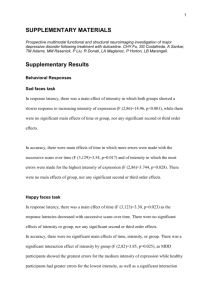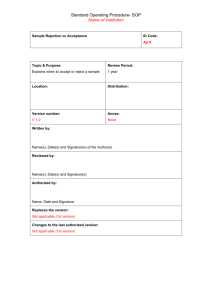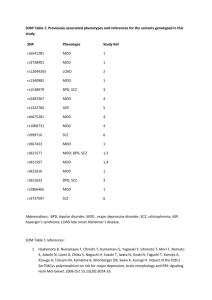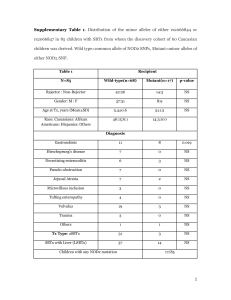Supplementary Information (doc 100K)
advertisement
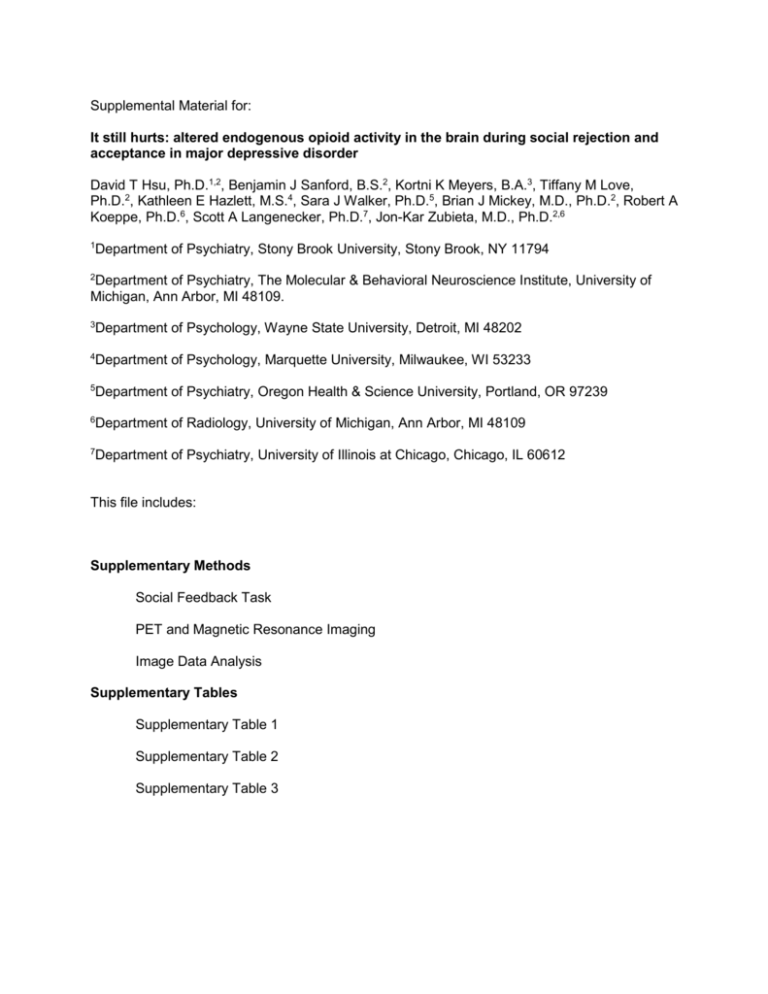
Supplemental Material for: It still hurts: altered endogenous opioid activity in the brain during social rejection and acceptance in major depressive disorder David T Hsu, Ph.D.1,2, Benjamin J Sanford, B.S.2, Kortni K Meyers, B.A.3, Tiffany M Love, Ph.D.2, Kathleen E Hazlett, M.S.4, Sara J Walker, Ph.D.5, Brian J Mickey, M.D., Ph.D.2, Robert A Koeppe, Ph.D.6, Scott A Langenecker, Ph.D.7, Jon-Kar Zubieta, M.D., Ph.D.2,6 1 Department of Psychiatry, Stony Brook University, Stony Brook, NY 11794 2 Department of Psychiatry, The Molecular & Behavioral Neuroscience Institute, University of Michigan, Ann Arbor, MI 48109. 3 Department of Psychology, Wayne State University, Detroit, MI 48202 4 Department of Psychology, Marquette University, Milwaukee, WI 53233 5 Department of Psychiatry, Oregon Health & Science University, Portland, OR 97239 6 Department of Radiology, University of Michigan, Ann Arbor, MI 48109 7 Department of Psychiatry, University of Illinois at Chicago, Chicago, IL 60612 This file includes: Supplementary Methods Social Feedback Task PET and Magnetic Resonance Imaging Image Data Analysis Supplementary Tables Supplementary Table 1 Supplementary Table 2 Supplementary Table 3 Social Feedback Task The social feedback task with positron emission tomography (PET) has been previously described1. In brief, several days before the PET scans, subjects were asked to rate online profiles of preferred-sex individuals with whom they would be most interested in forming a close relationship. A few days after profile ratings were obtained, subjects experienced blocks of feedback in which they were not liked (rejection) or liked (acceptance) by their highest-rated profiles during PET scanning. Rejection and acceptance blocks were 24 minutes each and contained 12 unique feedback trials of equal length. Within the same individuals, rejection and acceptance blocks were compared with baseline blocks, which contained a similar visual presentation but with no feedback. Block order was randomized and counterbalanced across subjects. For ethical reasons, this task did not involve deception – subjects were asked to imagine that the profiles and feedback were real. As a manipulation check, all subjects were given a brief questionnaire following the scan and asked on a scale of 1-5 (1 = very slightly or not at all, 2 = a little, 3 = moderately, 4 = quite a bit, 5 = extremely): 1) How much were you able to experience the profiles and feedback as if they were real? 2) How similar to a real-life situation was your emotional response to the positive feedback? 3) How similar to a real-life situation was your emotional response to the negative feedback? For HCs, the mean responses ± SD were 3.50 ± 0.92, 3.67 ± 0.91, and 3.44 ± 0.98, respectively. For MDD patients, mean responses ± SD were 3.24 ± 1.03, 3.29 ± 0.99, and 3.24 ± 0.90, respectively. There were no significant differences in these responses between HCs and MDD patients (two-sample t-tests, P’s > 0.25). PET and Magnetic Resonance Imaging Procedures for the acquisition and reconstruction of PET images, quantification of binding potential, and co-registration with structural MRs have been previously described1. Each subject completed two PET scans with [11C]carfentanil, a ligand with high and selective affinity for MORs2. Each of the scans contained two blocks: rejection and acceptance, or two baseline blocks. Block and scan order were randomized and counterbalanced across subjects. Thus, rejection and acceptance blocks were compared with baseline blocks acquired during the same post-injection time frame. At the beginning of each scan, intravenous catheters were placed in both arms: the right arm for infusion of the radiotracer, and the left arm for collecting blood samples. Subjects were given an intravenous bolus (50% of the total) followed by a 90-minute continuous infusion of [11C]carfentanil, which was synthesized at high specific activity (> 3000 Ci/mmol). On a separate day, high resolution structural MRIs were obtained. MRI images were co-registered with MOR binding maps, and used for spatial normalization to standard space (Montreal Neurological Institute, MNI). Image Data Analysis A priori volumes of interest (VOIs) included structures that are rich in MORs and respond to social rejection and/or physical pain1,3–6 and were identical to those used in a previous study1. Anatomical-based VOIs included the ventral striatum in the region of the nucleus accumbens (NAcc), amygdala, midline thalamus, periaqueductal gray (PAG), anterior insula, dorsal anterior cingulate cortex (dACC), and subgenual cingulate cortex (sgACC)1. An activation-based VOI was constructed from MOR peak deactivation in the pregenual anterior cingulate cortex (pgACC) found during self-induced sadness7. Contrasts of interest were modeled using Statistical Parametric Mapping (SPM8) (Wellcome Institute of Cognitive Neurology, London, UK). For subtraction analyses, one- or two-sample t-values were calculated for each voxel using a pooled smoothed variance across voxels8. Small volume correction masks for each VOI were applied to subtraction images in standardized space and α-levels were family-wise error (FWE) corrected. Data from VOIs were also extracted using MarsBaR region of interest toolbox (version 0.38) for SPM8 and correlated with Ego Resiliency, changes in affect, and changes in cortisol levels (Pearson’s r, two-tailed). Gender: women, men Age: mean years ± SD Education: mean years ± SD Ethnicity: Caucasian, African-American, Asian, Hispanic, other Sexual orientation: heterosexual, homosexual, bisexual Relationship status: single, in a relationship, married, divorced Supplementary Table 1. Subject demographics HC 13, 5 31.6 ± 11.5 15.3 ± 1.6 14, 2, 1, 1, 0 17, 0, 1 9, 5, 2, 2 MDD 13, 4 29.7 ± 10.1 15.8 ± 1.9 14, 0, 1, 1, 1 15, 1, 1 8, 4, 3, 2 ‘sad and rejected’ Self-Esteem Desire for Social Interaction Cortisol (µg/dL x 30min, AUC) ‘happy and accepted’ Self-Esteem Desire for Social Interaction Cortisol (µg/dL x 30min, AUC) Healthy Controls Baseline Rejection 1.2 ± 0.1 2.4 ± 0.2*** 45.6 ± 1.2 43.4 ± 1.5 16.1 ± 0.7 14.7 ± 0.9* 220.7 ± 47.2 212.0 ± 28.7 Baseline Acceptance 3.0 ± 0.2 4.0 ± 0.1*** 45.3 ± 1.3 46.1 ± 1.2* 15.9 ± 0.8 16.9 ± 0.7* 234.1 ± 45.9 252.3 ± 51.3 MDD Patients Baseline Rejection 2.1 ± 0.3 3.4 ± 0.2*** 22.4 ± 1.2 19.1 ± 1.1* 9.7 ± 1.0 7.1 ± 1.0*** 175.0 ± 31.1 197.1 ± 38.2 Baseline Acceptance 1.4 ± 0.1 3.3 ± 0.2*** 22.2 ± 1.1 26.3 ± 1.8 9.4 ± 0.8 10.8 ± 1.0 192.4 ± 34.8 197.3 ± 33.3 HC vs. MDD t 0.15 0.69 1.42 0.54 2.79** 1.69 0.49 0.17 Supplementary Table 2. Behavior and cortisol. Behavioral and cortisol measurements for HCs and MDD patients are shown at baseline, rejection, and acceptance. Significant changes from baseline are shown in asterisks (within-subjects two-tailed paired t-tests). The last column compares these changes between HCs and MDD patients (two-tailed t-test), and shows a significantly greater increase in “happy and accepted” from baseline during social acceptance in MDD patients compared to HCs. *P < 0.05, **P < 0.01, ***P < 0.001. AUC, area under the curve; HC, healthy controls; MDD, major depressive disorder MOR Activation MOR Activation (Baseline – Rejection) (Baseline – Acceptance) VOI HC > MDD MDD > HC HC > MDD MDD > HC Peak t Peak t --- --- --- --- 15, 12, -3 3.73** --- --- Amygdala (L) -20, -3, -27 5.19*** --- --- Amygdala (R) 18, 2, -18 5.25*** --- --- --- --- Midline Thalamus 3, -18, 6 --- --- --- --- --- --- --- --- --- --- --- --- NAcc (L) NAcc (R) PAG 3.53** 0, -34, -12 2.41* Peak t -10, 15, -12 2.92+ --- --- -24, -1, -15 4.50** Anterior Insula (R) --- --- --- --- 46, 4, -6 3.02* sgACC --- --- --- --- --- --- Peak t -8, 9, -6 3.49* --- --- --- --- --- --- 0, -13, 7 4.14** -2, 9, -5 5.81*** Supplementary Table 3. MOR activation during rejection and acceptance: group comparisons. Locations of peaks are shown in x, y, z coordinates (mm) in MNI space. +P = 0.05, *P < 0.05, **P < 0.01, ***P < 0.001, small volume correction (SVC). Dashes indicate no clusters detected at a threshold of p ≤ 0.05. As reported in the main text for within-group analyses in HCs, MOR deactivation was found during acceptance in the midline thalamus and, therefore in the group analyses MOR activation during acceptance was greater in MDD patients in the midline thalamus and a cluster peak-centered in the sgACC that spread to the dorsal medial border of the left NAcc. In HCs, MOR activation in the left NAcc during acceptance approached statistical significance (P = 0.05, SVC). No significant group differences in MOR activation were found in the left anterior insula, dorsal anterior cingulate, or pregenual anterior cingulate cortex during either rejection or acceptance. VOI, volume of interest; MOR, µ-opioid receptor; HC, healthy control; MDD, major depressive disorder; NAcc, nucleus accumbens; PAG, periaqueductal gray; sgACC, subgenual anterior cingulate cortex; L, left; R, right REFERENCES 1 Hsu DT, Sanford BJ, Meyers KK, Love TM, Hazlett KE, Wang H et al. Response of the μopioid system to social rejection and acceptance. Mol Psychiatry 2013; 18: 1211–1217. 2 Titeler M, Lyon RA, Kuhar MJ, Frost JF, Dannals RF, Leonhardt S et al. Mu opiate receptors are selectively labelled by [3H]carfentanil in human and rat brain. Eur J Pharmacol 1989; 167: 221–228. 3 Zubieta JK, Smith YR, Bueller JA, Xu Y, Kilbourn MR, Jewett DM et al. Regional mu opioid receptor regulation of sensory and affective dimensions of pain. Science 2001; 293: 311– 315. 4 Way BM, Taylor SE, Eisenberger NI. Variation in the mu-opioid receptor gene (OPRM1) is associated with dispositional and neural sensitivity to social rejection. Proc Natl Acad Sci U S A 2009; 106: 15079–15084. 5 Kross E, Berman MG, Mischel W, Smith EE, Wager TD. Social rejection shares somatosensory representations with physical pain. Proc Natl Acad Sci U S A 2011; 108: 6270–6275. 6 Dewall CN, Macdonald G, Webster GD, Masten CL, Baumeister RF, Powell C et al. Acetaminophen reduces social pain: behavioral and neural evidence. Psychol Sci 2010; 21: 931–937. 7 Zubieta J-K, Ketter TA, Bueller JA, Xu Y, Kilbourn MR, Young EA et al. Regulation of human affective responses by anterior cingulate and limbic mu-opioid neurotransmission. Arch Gen Psychiatry 2003; 60: 1145–1153. 8 Worsley KJ, Evans AC, Marrett S, Neelin P. A three-dimensional statistical analysis for CBF activation studies in human brain. J Cereb Blood Flow Metab Off J Int Soc Cereb Blood Flow Metab 1992; 12: 900–918.




